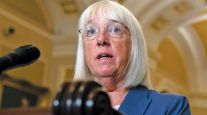Senior Reporter
FMCSA Accepts, Will Act on CSA Recommendations, Agency’s Chief Counsel Says
The top attorney for the Federal Motor Carrier Safety Administration said the agency is moving forward with plans in support of recommendations by a panel of elite academics for a new approach to measuring motor carrier safety scores.
“We at FMCSA have been waiting for this study for 18 months,” Randi Hutchinson, chief counsel for FMCSA, told Transport Topics in a June 29 interview. “We accept it. That’s what we’re moving toward.”
Hutchinson, recently named to the chief counsel post, said the agency is “taking the recommendations to heart” and the agency “intends to immediately start working on them. We have 120 days to prepare an action plan that we will then present to Congress and to the office of the inspector general.”
The study, fashioned by a 12-member panel of academics chosen by the National Academies of Sciences, Engineering and Medicine, concluded that FMCSA’s Compliance, Safety, Accountability program’s controversial Safety Measurement System to identify motor carriers at high risk for future crashes is “conceptually sound” but several features need improvement.
While the panel’s report was complimentary of the agency for many of its ideas and efforts, it recommended that over the next two years, regulators develop a more “statistically principled approach” based on an “item response theory” — that is, a more detailed data-oriented approach that digs deeper and measures the performance of individual trucks and buses, not just at the motor carrier level.
FMCSA Chief Counsel Randi Hutchinson shares the importance of truck safety enforcement at @ndaajustice's CMV Partnership conference pic.twitter.com/2Fs1uPQqkz — FMCSA (@FMCSA) June 15, 2017
“We were pleased that the National Academy of Sciences study found that the current safety management system is structured in a reasonable way and that its method of identifying motor carriers for alert status is defensible,” Hutchinson said. “We were also pleased that they found that the agency’s overall approach, which is based on crash prevention, rather than prediction, is sound.”
She added, “We realize that we can always get better, and the study said that we could get better. They specifically suggested that we move toward an item response theory over the next two years.”
The national academy study was mandated by the 2015 Fast Act and was funded by FMCSA. The mandate requires that the agency complete an action plan within 120 days.
Hutchinson said on June 29, that FMCSA conducted several briefing phone calls on the national academy study with Senate and House transportation staff members and trucking industry stakeholders, who generally supported the academy recommendations.
Hutchinson said the agency told stakeholders they would be soliciting their input as officials work on the action plan and as they work over the next two years to implement the IRT concept.
“We’re still setting up the framework of how we’re going to move forward, she said. “I’m sure there are going to be challenges. There are challenges anytime that you do something new.”
The agency also plans to work closely with the national academy in creating the new approach.
“We’re going to continue to tap into the expertise of the people who were involved in putting this study together,” Hutchinson said. “We’re going to reach out to others in academia and foundations — anywhere we can get some expertise to help us move forward.”
She added, “This is not just an FMCSA system. We run the system but we all have a stake in safety on the road. We could argue that no one has more of a stake than the drivers and the companies themselves. They want unsafe drivers and carriers off the road as much as anyone.
“We were pleased to have their vote of confidence.”
The academies’ panel was charged with analyzing the ability of FMCSA’s SMS to discriminate between low- and high-risk carriers, assess the public usage of SMS, review the data and methodology used to calculate the measures and provide advice on additional data collection and safety assessment methodologies.
In March, FMCSA withdrew a January 2016 proposed motor carrier safety fitness rule, saying it was awaiting the results of the study before proceeding with a subsequent proposal.




